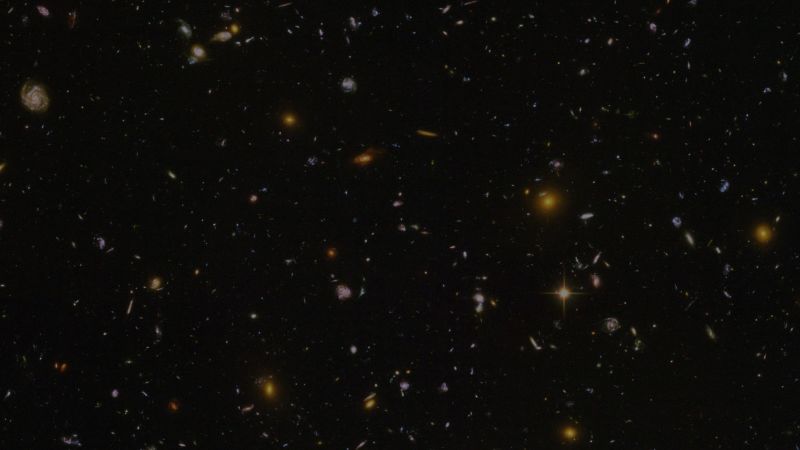The supermassive black hole at the center of our galaxy, Sagittarius A*, is spinning rapidly and altering space-time around it, a new study has found.
Space-time is the four-dimensional continuum that describes how we see space, fusing one-dimensional time and three-dimensional space together to represent the space fabric that curves in response to massive celestial bodies.
A team of physicists observed the black hole, which is located 26,000 light-years from Earth, with NASA’s Chandra X-ray Observatory, a telescope designed to detect the X-ray emissions from hot regions of the universe. They calculated Sagittarius A*’s rotational speed by using what is known as the outflow method, which looks at radio waves and X-ray emissions that can be found in the material and gases surrounding black holes, otherwise known as the accretion disk, according to the study published October 21 in the Monthly Notices of the Royal Astronomical Society.
The researchers confirmed that the black hole is spinning, which causes what is known as the Lense-Thirring effect. Also known as frame dragging, the Lense-Thirring effect is what happens when a black hole drags space-time along with its spin, said lead study author Ruth Daly, a physics professor at Penn State University who designed the outflow method over a decade ago.
Since the invention of the outflow method, Daly has been working to determine the spin of various black holes and authored a 2019 study that explored over 750 supermassive black holes.
“With this spin, Sagittarius A* will be dramatically altering the shape of space-time in its vicinity,” Daly said. “We’re used to thinking and living in a world where all the spatial dimensions are equivalent — the distance to the ceiling and the distance to the wall and the distance to the floor … they all sort of are linear, it’s not like one is totally squished up compared to the others.
“But if you have a rapidly rotating black hole, the space-time around it is not symmetric — the spinning black hole is dragging all of the space-time around with it … it squishes down the space-time, and it sort of looks like a football,” she said.
The altering of space-time is nothing to worry about, but illuminating this phenomenon could be very useful to astronomers, Daly said.
“It’s a wonderful tool to understand the role that black holes play in galaxy formation and evolution,” she said. “The fact that they’re dynamical entities which can be spinning … and then that can impact the galaxy that this is sitting in — it’s very exciting and very interesting.”
The spin of supermassive black holes
The spin of a black hole is given a value from 0 to 1, with 0 meaning the black hole is not spinning, and 1 being the maximum spin value. Previously there was no consensus on a value for the spin of Sagittarius A*, Daly said.
With the outflow method, which is the only method that uses both information from the outflow and from the material within the vicinity of the black hole, Daly said, Sagittarius A* was found to have a spin angular momentum value between 0.84 and 0.96, whereas M87* — a black hole in the Virgo galaxy cluster that is 55 million light-years from Earth, was found to spin at the value of 1 (with a larger uncertainty of plus or minus 0.2) and is near the maximum for its mass.
While the team had found the two black holes to be spinning at similar rates, M87* is much more massive than Sagittarius A*, Daly said, so Sagittarius A* has less distance to cover and spins more times per one spin of M87*.
Sagittarius A* “is spinning much more rapidly (in comparison), not because it has a higher spin angular momentum, but because it has less distance to travel when it goes around once,” Daly explained.
Black holes and galactic history
Knowing the mass and the spin of a black hole helps astronomers understand how the black hole might have formed and evolved, Daly said.
Black holes that formed as a result of smaller black holes merging would typically see a low spin value, said Dejan Stojkovic, a professor of cosmology at the University at Buffalo who was not involved with the study. However, a black hole that was made with accretion of surrounding gas would see a high spin value.
The rate at which Sagittarius A* is spinning would indicate that a significant portion of the mass of the black hole came from accretion, he said.
“The question of whether our central galactic black hole rotates or not, or how fast it rotates, is quite important,” Stojkovic said in an email.
“Ultimately, we want to measure the properties of the center of our galaxy as good as possible. This way we can learn about the history and structure of our galaxy, put our theories to (the) test, or even infer the existence of some very interesting and intriguing objects like wormholes,” added Stojkovic, who was the lead author of a 2019 study on the hypothetical structures.







































